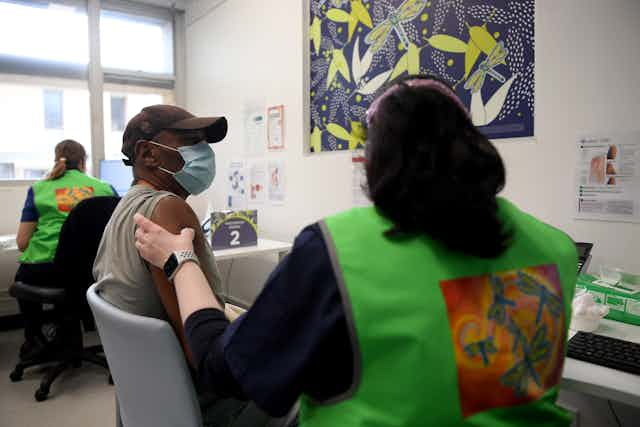At the beginning of the COVID-19 pandemic, the federal government’s pandemic response struggled to include the country’s most minoritised groups, including First Nations people.
Daily press conferences were broadcast, but the messages were not delivered or received equally across the country. Trust in the people delivering the messages and ability to follow health advice varies according to personal, social and cultural experiences.
Our study found First Nations people in rural NSW experienced significantly more anxiety and fear about COVID-19 than non-First Nations Australians.
Read more: The first Indigenous COVID death reminds us of the outsized risk NSW communities face
Australia’s bungled response to communities hit hard by COVID
At the beginning of the pandemic Australia’s strategy resulted in low numbers of infected people until the Delta variant emerged. Then First Nations rural and remote communities were essentially left to fend for themselves. Even though First Nations people were found to be at greater risk of death and illness during past influenza pandemics.
The Aboriginal community-controlled health sector’s strengths based communication strategy led to culturally appropriate responses including the creation of pandemic tool kits and infection control advice. In some places this included closing remote communities and developing localised social media campaigns for these sites.
However, the Delta variant’s spread through Western NSW revealed limited access to vaccination and government’s failure to consult with hard-hit communities. These problems were compounded by complicated messages and limited attention to rural communities that has been a feature of pandemic communications in Australia.
Research limited with structurally marginalised communities
The research community responded rapidly to the need to investigate and inform responses to the pandemic. However, there was limited research about rural First Nations people’s perceptions of COVID-19 risks, or their information or communication needs.
There was also limited attention to the community needs in NSW where the largest population of First Nations peoples live in Australia.
Read more: Access to a second COVID booster vaccine has been expanded to people 30 years and over
Study reveals how concerning COVID was for rural NSW First Nations communities
In our study we tested the links between age, sex, First Nations status, access to healthcare and family situation. We also asked how often First Nations people felt fearful about COVID-19, and how harmful they thought the virus was.
First Nations peoples felt afraid more often than non-First Nations people did. They also felt it was highly likely they would catch the virus, and that it would be very harmful to them and their community.
Nearly 60% of First Nations peoples thought there was nothing they could do about COVID-19, and only 11.6% of the rest of the sample agreed with this statement. This is interesting because when vaccines were first made available in Australia, First Nations people were identified as a high priority group.
Their fears were justified because the Delta variant of COVID-19 quickly took hold in small communities that have limited healthcare services. The availability of services needed to provide vaccinations was not taken into account in vaccine rollout plans.
Read more: Natural disasters and the COVID-19 pandemic reveal the crucial role of First Nations media
Fear and mistrust stem from historical trauma
Our survey results of fear and perceptions of harm from COVID-19 is understandable when previous poor health care experiences and past harmful government practices has to led to distrust in health care by many First Nations Peoples.
Notably, two things that predicted high levels of anxiety in survey respondents were common to First Nations people in rural NSW - living with children under 18 years of age and living in small rural towns more than 20 kilometres away from the nearest health service.
One quarter of the First Nations population in Australia already experienced anxiety and depression before the pandemic. Lack of confidence in health services and health communications have been identified as things that will make anybody’s existing mental health conditions worse.
Fear of COVID infection has been linked to long-lasting post-traumatic stress symptoms. Combined with a shortage of mental health services in rural areas, there is an urgent need to consult with communities about how best to support them.
Co-designed health communication necessary
There were no First Nations representatives in daily government press conferences delivering health advice even though there were frequent mentions of risks to First Nations communities.
Different populations require nuanced communications that address their fears and concerns. To overcome distrust of government and poor health care experiences, including First Nations Australians in health communication design and delivery is essential.

